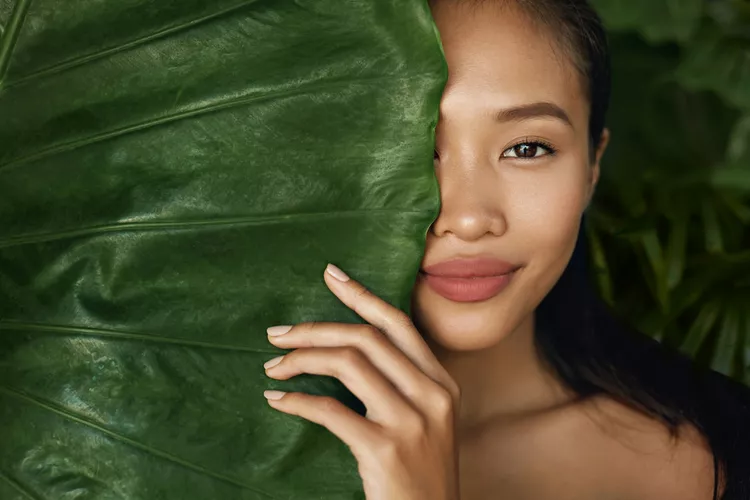Transformative Global Trends: Asia Redefining Beauty

In Asia, China is leading the way in the beauty trend of implementing AI and AR technology for its hyper-digital consumer
market. In 2020, during the height of the COVID-19 pandemic, Perfect Corp and the Chinese app WeChat launched an AI
and AR beauty service that allowed Chinese consumers to enjoy a digital beauty experience from their mobile devices.
Beauty brands in Asia are now adopting this technologically advanced innovation to offer consumers ease in virtually trying
out beauty products.
Holistic skin health continues to be in the spotlight in the post-pandemic era
In 2022, amidst the prolonged impact of COVID-19 restrictions, there was a persistent focus on skin health that evolved
into a comprehensive trend encompassing “whole body” well-being. Throughout this year, the field of dermocosmetics
beauty and personal care exhibited a remarkable growth of 6.4%, countering the general market downturn. This growth
trajectory is expected to extend into 2023. Notably, Chinese consumers displayed a shifting preference toward restorative
and soothing properties in products, a shift that followed the precedence of whitening and anti-aging benefits.
Furthermore, the notion of skinification expanded to hair care, underscoring the desire for skin health principles to infiltrate
various aspects of personal care. The inclination towards vibrant and naturally healthy appearances in color cosmetics
also mirrors consumers’ holistic concerns for inner and outer skin vitality. Simultaneously, the concept of skin microecology
garnered unprecedented attention, largely attributed to claims of barrier repair. This focus led to not only international giants
like L’Oréal and Procter & Gamble but also domestic brands like Dr. Alva and Home Facial Pro exploring and expanding
their presence in this domain, revealing significant growth potential within the market.
Self-orientated beautification
The perception of beauty in China is in a state of continuous evolution, and in recent times, it has gravitated towards the
acceptance of individuality and inner confidence, driven by the growing awareness of self-love and the rise of individualism.
Prioritizing self-appreciation and embracing one’s innate, distinctive beauty has emerged as a fresh aspiration among
consumers in the beauty and personal care sphere, with emotional and psychological contentment progressively influencing
consumer choices.
Among female Chinese consumers, the leading interpretations of beauty now encompass inner confidence,
optimal appearance, and a healthy visage.
The mainstay of well-being products consumption with emotional value
The fragrance industry is displaying early signs of resurgence in 2023, although facing an initial setback in 2022 due to
restricted consumption amid home seclusion, retaining substantial growth potential. Emotionally resonant products
continue to anchor consumption, with niche brands like Maison Margiela and Le Labo garnering momentum in the Chinese
market, translating into impressive sales performances across recent years.
Increased market competition, coupled with potential arising in niche markets
The rise of domestic brands has coincided with a transformation in the Chinese beauty and personal care sector. In contrast
to global counterparts, local brands exhibit heightened adaptability in marketing approaches and swifter responsiveness to
consumer needs. Notably, local brands can compress their research and development (R&D) timeline to 3-6 months, a process
that typically takes international brands over twice the duration to accomplish product updates. Leveraging enhanced R&D
capabilities, domestic brands offer exceptional cost-effectiveness, presenting equally efficacious options at more accessible
price points, thus facilitating their substitution by progressively discerning consumers.
Shaping the Future Landscape: Navigating the Dynamics Between Local
and International Beauty Brands
However, the trajectory of local brands might encounter some limitations, notably encompassing the enduring facets of
developing a robust brand identity and navigating the intricacies of sustaining an economically accessible pricing strategy.
As the zero-COVID policy wanes, the resurgence of international brands is poised to take center stage, wielding their formidable
brand equity and cutting-edge research and development prowess to assert their authority over pricing dynamics and the
premium market segment. This resurgence is anticipated to catalyze a heightened sense of competition within the beauty and
personal care landscape, injecting a new layer of intensity and dynamism.
Revitalizing Momentum: The Post-Zero-COVID Era Beckons a Resurgence
in China’s Market
According to Euromonitor International, China’s beauty and personal care market is poised for continual expansion,
projecting a robust Compound Annual Growth Rate (CAGR) of 6.5% from 2022 to 2027. The anticipated easing of the
zero-COVID policy and subsequent reopening stand as pivotal catalysts, propelling the engines of Chinese beauty and personal
care. As China’s economy rebounds, a surge in consumer confidence is on the horizon. Notably, the diversification of sales
channels is primed to further invigorate the market, spotlighting platforms like Douyin, a trend-driven e-commerce platform,
and well-established online retailers such as JD.com, as burgeoning forces in the realm of beauty and personal care products.
Continued education of the market also remains an indispensable factor in propelling future growth. As top-tier cities mature
in their market presence, it is the lower-tier markets that beckon with latent growth potential, promising a landscape rich with
untapped opportunities.
Radiating Growth: Halal Beauty Products Illuminate Southeast Asia’s Beauty Landscape
In the vibrant tapestry of Southeast Asia, nations like Indonesia and Malaysia stand as beacons of halal beauty’s meteoric rise,
fueled by their predominantly Muslim population. As we step into 2023, the beauty and personal care industry is poised for a
remarkable ascent – a projected 10% surge in Indonesia and an even more exhilarating 15% leap in Malaysia. This surge
doesn’t merely denote growth; it heralds a revolution in the presence of halal beauty products within these markets.
The heartening narrative unfolds further as we witness Indonesia’s halal beauty sector evolving from strength to strength,
undergoing a transformative journey from 2.7% to a resounding 7.1% between 2019 and 2022. This journey is a testament
to the harmony between cultural values and contemporary aspirations, where halal beauty steps into the limelight as a symbol
of authenticity and inclusivity.
Elevating Halal Beauty: Embracing Transparency and Compassion
In a world where knowledge is power, halal beauty paves the way for informed choices. The allure isn’t confined to any
particular creed; it resonates with all seekers of authenticity. As the beauty industry resonates with the call for ingredient
transparency, halal beauty stands at the forefront. The desire to know what touches our skin drives not just Muslim consumers,
but a growing tide of beauty enthusiasts to seek brands that unveil the secrets within.
The synergy between ethical aspirations, beauty that’s beyond skin-deep, and the embrace of nature itself creates a compelling
narrative. It’s a journey where beauty is nurtured ethically, sustainability is etched into every choice, and the essence of well-being
radiates from within each product. In this tapestry of values, halal beauty finds its vibrant place, flourishing not merely as a trend
but as a philosophy that resonates with the conscience of today’s beauty connoisseurs.
